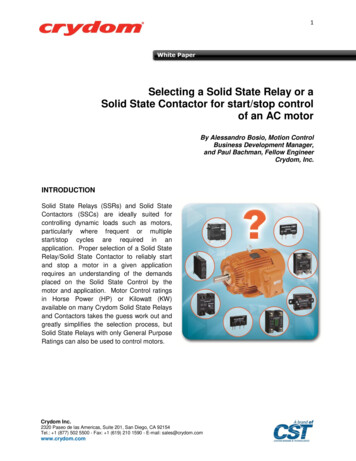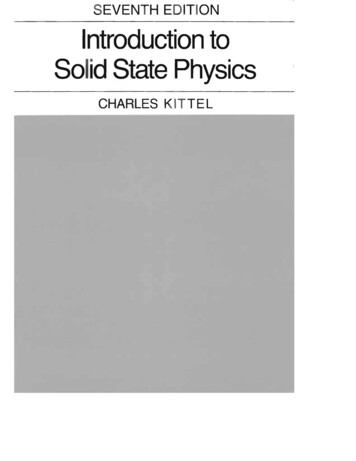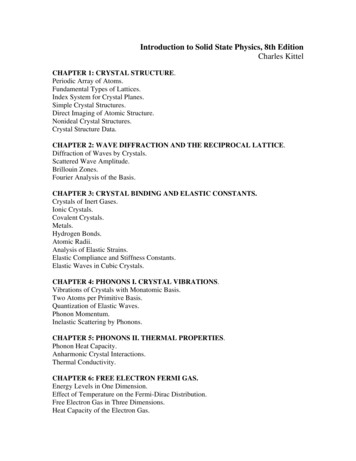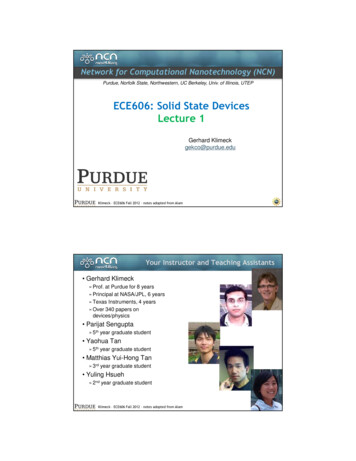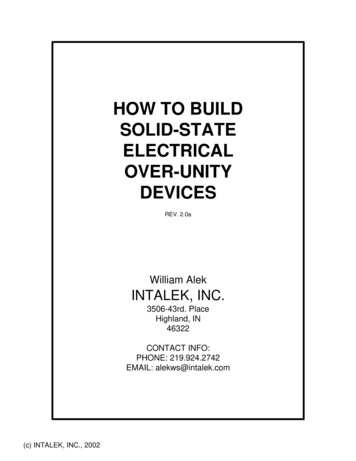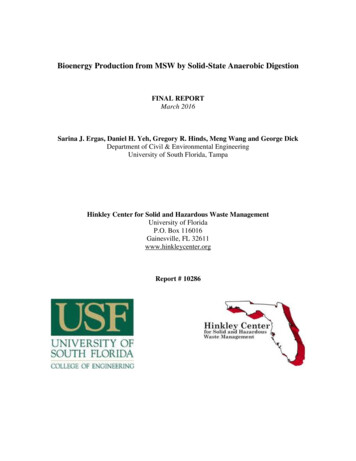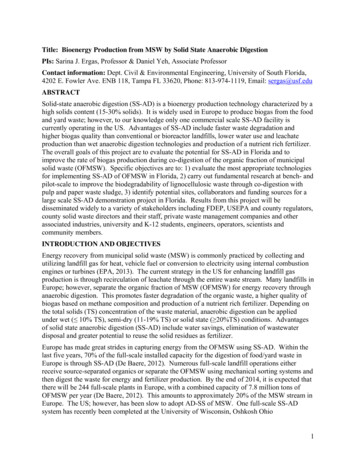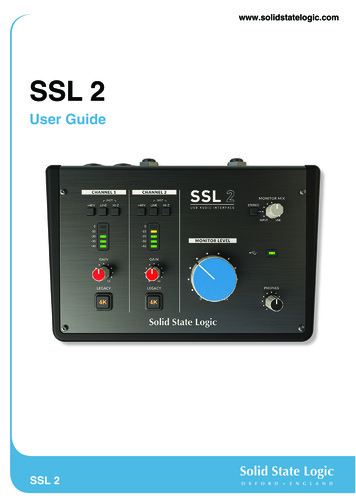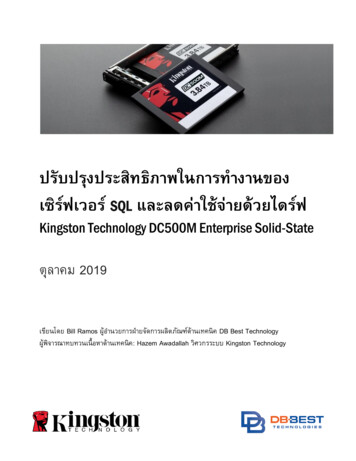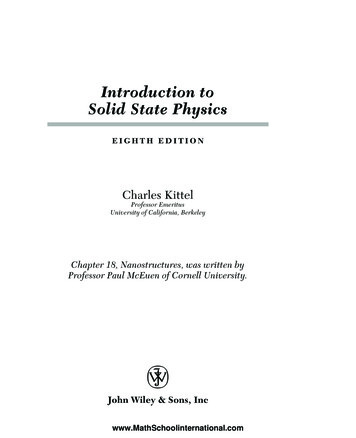
Transcription
Introduction toSolid State PhysicsEIGHTH EDITIONCharles KittelProfessor EmeritusUniversity of California, BerkeleyChapter 18, Nanostructures, was written byProfessor Paul McEuen of Cornell University.John Wiley & Sons, Incwww.MathSchoolinternational.com
EXECUTIVE EDITORStuart JohnsonSENIOR PRODUCTION EDITORPatricia McFaddenSENIOR MARKETING MANAGERDESIGN DIRECTORRobert SmithMadelyn LesureSENIOR MEDIA EDITORMartin BateyPRODUCTION MANAGEMENTSuzanne Ingrao/Ingrao AssociatesThis book was set in 10/12 New Caledonia by GGS Books Services, Atlantic Highlands andprinted and bound by Malloy Lithographing. The cover was printed by Phoenix Color.This book is printed on acid free paper. Copyright 2005 John Wiley & Sons, Inc. All rights reserved.No part of this publication may be reproduced, stored in a retrieval system or transmitted in anyform or by any means, electronic, mechanical, photocopying, recording, scanning or otherwise,execpt as permitted under Sections 107 or 108 of the 1976 United States Copyright Act, withouteither the prior written permission of the Publisher, or authorization through payment of theappropriate per-copy fee to the Copyright Clearance Center, Inc. 222 Rosewood Drive,Danvers, MA 01923, (978)750-8400, fax (978)646-8600. Requests to the Publisher for permissionshould be addressed to the Permissions Department, John Wiley & Sons, Inc., 111 River Street,Hoboken, NJ 07030-5774, (201)748-6011, fax (201)748-6008.To order books or for customer service please, call 1-800-CALL WILEY (225-5945).Library of Congress Cataloging in Publication Data:Kittel, Charles.Introduction to solid state physics / Charles Kittel.—8th ed.p. cm.ISBN 0-471-41526-X1. Solid state physics. I. Title.QC176.K5 2005530.4 1—dc22ISBN 0-471-41526-XWIE ISBN 0-471-68057-5Printed in the United States of America10 9 8 7 6 5 4 3 2 1www.MathSchoolinternational.com2004042250
About the AuthorCharles Kittel did his undergraduate work in physics at M.I.T and at theCavendish Laboratory of Cambridge University. He received his Ph.D. fromthe University of Wisconsin. He worked in the solid state group at BellLaboratories, along with Bardeen and Shockley, leaving to start the theoreticalsolid state physics group at Berkeley in 1951. His research has been largely inmagnetism and in semiconductors. In magnetism he developed the theories offerromagnetic and antiferromagnetic resonance and the theory of singleferromagnetic domains, and extended the Bloch theory of magnons. In semiconductor physics he participated in the first cyclotron and plasma resonanceexperiments and extended the results to the theory of impurity states and toelectron-hole drops.He has been awarded three Guggenheim fellowships, the Oliver BuckleyPrize for Solid State Physics, and, for contributions to teaching, the OerstedMedal of the American Association of Physics Teachers. He is a member ofthe National Academy of Science and of the American Academy of Arts andSciences.www.MathSchoolinternational.com
PrefaceThis book is the eighth edition of an elementary text on solid state/condensed matter physics for seniors and beginning graduate students of thephysical sciences, chemistry, and engineering. In the years since the first edition was published the field has developed vigorously, and there are notableapplications. The challenge to the author has been to treat significant newareas while maintaining the introductory level of the text. It would be a pity topresent such a physical, tactile field as an exercise in formalism.At the first edition in 1953 superconductivity was not understood; Fermisurfaces in metals were beginning to be explored and cyclotron resonance insemiconductors had just been observed; ferrites and permanent magnets werebeginning to be understood; only a few physicists then believed in the reality ofspin waves. Nanophysics was forty years off. In other fields, the structure ofDNA was determined and the drift of continents on the Earth was demonstrated. It was a great time to be in Science, as it is now. I have tried with thesuccessive editions of ISSP to introduce new generation to the same excitement.There are several changes from the seventh edition, as well as muchclarification: An important chapter has been added on nanophysics, contributed by anactive worker in the field, Professor Paul L. McEuen of Cornell University.Nanophysics is the science of materials with one, two, or three small dimensions, where “small” means nanometer 10 9 m) This field is the most exciting and vigorous addition to solid state science in the last ten years. The text makes use of the simplifications made possible by the universalavailability of computers. Bibliographies and references have been nearlyeliminated because simple computer searches using keywords on a searchengine such as Google will quickly generate many useful and more recentreferences. As an example of what can be done on the Web, explore theentry http://www.physicsweb.org/bestof/cond-mat. No lack of honor is intended by the omissions of early or traditional references to the workerswho first worked on the problems of the solid state. The order of the chapters has been changed: superconductivity andmagnetism appear earlier, thereby making it easier to arrange an interestingone-semester course.The crystallographic notation conforms with current usage in physics. Important equations in the body of the text are repeated in SI and CGS-Gaussianunits, where these differ, except where a single indicated substitution willtranslate from CGS to SI. The dual usage in this book has been found helpfuland acceptable. Tables are in conventional units. The symbol e denotes thewww.MathSchoolinternational.com
Prefacecharge on the proton and is positive. The notation (18) refers to Equation 18of the current chapter, but (3.18) refers to Equation 18 of Chapter 3. A caret (ˆ)over a vector denotes a unit vector.Few of the problems are exactly easy: Most were devised to carry forwardthe subject of the chapter. With few exceptions, the problems are those of theoriginal sixth and seventh editions. The notation QTS refers to my QuantumTheory of Solids, with solutions by C. Y. Fong; TP refers to Thermal Physics,with H. Kroemer.This edition owes much to detailed reviews of the entire text by ProfessorPaul L. McEuen of Cornell University and Professor Roger Lewis of WollongongUniversity in Australia. They helped make the book much easier to read and understand. However, I must assume responsibility for the close relation of the textto the earlier editions, Many credits for suggestions, reviews, and photographsare given in the prefaces to earlier editions. I have a great debt to Stuart Johnson,my publisher at Wiley; Suzanne Ingrao, my editor; and Barbara Bell, my personal assistant.Corrections and suggestions will be gratefully received and may be addressed to the author by email to kittel@berkeley.edu.The Instructor’s Manual is available for download at www.wiley.com/college/kittel.Charles Kittelwww.MathSchoolinternational.comv
www.MathSchoolinternational.com
ContentsCHAPTER 1: CRYSTAL STRUCTUREPeriodic Array of Atoms13Lattice Translation VectorsBasis and the Crystal StructurePrimitive Lattice Cell456Fundamental Types of Lattices6Two-Dimensional Lattice TypesThree-Dimensional Lattice Types89Index Systems for Crystal Planes11Simple Crystal Structures13Sodium Chloride StructureCesium Chloride StructureHexagonal Close-Packed Structure (hcp)Diamond StructureCubic Zinc Sulfide Structure1314151617Direct Imaging of Atomic Structure18Nonideal Crystal Structures18Random Stacking and Polytypism19Crystal Structure Data19Summary22Problems22CHAPTER 2: WAVE DIFFRACTION AND THE RECIPROCALLATTICE23Diffraction of Waves by Crystals25Bragg Law25Scattered Wave Amplitude26Fourier AnalysisReciprocal Lattice VectorsDiffraction ConditionsLaue Equations27293032Brillouin ZonesReciprocal Lattice to sc LatticeReciprocal Lattice to bcc LatticeReciprocal Lattice to fcc Latticewww.MathSchoolinternational.com33343637
viiiFourier Analysis of the BasisStructure Factor of the bcc LatticeStructure factor of the fcc LatticeAtomic Form Factor404041Summary43Problems43CHAPTER 3: CRYSTAL BINDING AND ELASTIC CONSTANTSCrystals of Inert GasesVan der Waals—London InteractionRepulsive InteractionEquilibrium Lattice ConstantsCohesive EnergyIonic CrystalsElectrostatic or Madelung EnergyEvaluation of the Madelung Constant474953565859606064Covalent Crystals67Metals69Hydrogen Bonds70Atomic Radii70Ionic Crystal RadiiAnalysis of Elastic StrainsDilationStress ComponentsElastic Compliance and StiffnessConstantsElastic Energy DensityElastic Stiffness Constants of Cubic CrystalsBulk Modulus and CompressibilityCHAPTER397273757577777880Elastic Waves in Cubic Crstals80Waves in the [100] DirectionWaves in the [110] Direction8182Summary85Problems854: PHONONS I. CRYSTAL VIBRATIONSVibrations of Crystals with Monatomic BasisFirst Brillouin ZoneGroup Velocitywww.MathSchoolinternational.com89919394
ContentsLong Wavelength LimitDerivation of Force Constants from Experiment9494Two Atoms per Primitive Basis95Quantization of Elastic Waves99Phonon Momentum100Inelastic Scattering by Phonons100Summary102Problems102CHAPTER 5: PHONONS 11. THERMAL PROPERTIESPhonon Heat CapacityPlanck DistributionNormal Mode EnumerationDensity of States in One DimensionDensity of States in Three DimensionsDebye Model for Density of StatesDebye T3 LawEinstein Model of the Density of StatesGeneral Result for D(w)Anharmonic Crystal al Expansion120Thermal Conductivity121Thermal Resistivity of Phonon GasUmklapp ProcessesImperfecionsProblemsCHAPTER 6: FREE ELECTRON FERMI GAS123125126128131Energy Levels in One Dimension134Effect of Temperature on the FermiDirac Distribution136Free Electron Gas in Three Dimensions137Heat Capacity of the Electron Gas141Experimental Heat Capacity of MetalsHeavy Fermions145147Electrical Conductivity and Ohm’s Law147Experimental Electrical Resistivity of MetalsUmklapp Scatteringwww.MathSchoolinternational.com148151ix
xMotion in Magnetic FieldsHall EffectThermal Conductivity of MetalsRatio of Thermal to Electrical ConductivityProblemsCHAPTER 7: ENERGY BANDS152153156156157161Nearly Free Electron Model164Origin of the Energy GapMagnitude of the Energy Gap165167Bloch Functions167Kronig-Penney Model168Wave Equation of Electron in aPeriodic Potential169Restatement of the Bloch TheoremCrystal Momentum of an ElectronSolution of the Central EquationKronig-Penney Model in Reciprocal SpaceEmpty Lattice ApproximationApproximate Solution Near a Zone BoundaryNumber of Orbitals in a BandMetals and ms182CHAPTER 8: SEMICONDUCTOR CRYSTALS185Band Gap187Equations of Motion191.Physical Derivation of k FHolesEffective MassPhysical Interpretation of the Effective MassEffective Masses in SemiconductorsSilicon and GermaniumIntrinsic Carrier ConcentrationIntrinsic MobilityImpurity ConductivityDonor StatesAcceptor StatesThermal Ionization of Donors and 98200202205208209209211213
ContentsThermoelectric Effects214Semimetals215Superlattices216Bloch OscillatorZener TunnelingCHAPTER 9:217217Summary217Problems218FERMI SURFACES AND METALSReduced Zone SchemePeriodic Zone SchemeConstruction of Fermi SurfacesNearly Free Electrons221223225226228Electron Orbits, Hole Orbits, and Open Orbits230Calculation of Energy Bands232Tight Binding Method of Energy BandsWigner-Seitz MethodCohesive EnergyPseudopotential MethodsExperimental Methods in Fermi Surface StudiesQuantization of Orbits in a Magnetic FieldDe Haas-van Alphen EffectExtremal OrbitsFermi Surface of CopperMagnetic roblems252CHAPTER 10: SUPERCONDUCTIVITYExperimental SurveyOccurrence of SuperconductivityDestruction of Superconductivity of Magnetic FieldsMeissner EffectHeat CapacityEnergy GapMicrowave and Infrared PropertiesIsotope EffectTheoretical SurveyThermodynamics of the Superconducting TransitionLondon 2262264266268269270270273xi
xiiCoherence LengthBCS Theory of SuperconductivityBCS Ground StateFlux Quantization in a Superconducting RingDuration of Persistent CurrentsType II SuperconductorsVortex StateEstimation of Hc1 and Hc2Single Particle TunnelingJosephson Superconductor TunnelingDc Josephson EffectAc Josephson EffectMacroscopic Quantum 2High-Temperature 6CHAPTER 11: DIAMAGNETISM AND PARAMAGNETISM297Langevin Diamagnetism Equation299Quantum Theory of Diamagnetism ofMononuclear Systems301Paramagnetism302Quantum Theory of Paramagnetism302Rare Earth IonsHund RulesIron Group IonsCrystal Field SplittingQuenching of the Orbital Angular MomentumSpectroscopic Splitting FactorVan Vleck Temperature-Independent ParamagnetismCooling by Isentropic DemagnetizationNuclear etic Susceptibility of Conduction Electrons315Summary317Problems318CHAPTER 12: FERROMAGNETISM AND ANTIFERROMAGNETISMFerromagnetic OrderCurie Point and the Exchange Integralwww.MathSchoolinternational.com321323323
ContentsTemperature Dependence of the SaturationMagnetizationSaturation Magnetization at Absolute ZeroMagnonsQuantization of Spin WavesThermal Excitation of Magnons326328330333334Neutron Magnetic Scattering335Ferrimagnetic Order336Curie Temperature and Susceptibilityof FerrimagnetsIron GarnetsAntiferromagnetic OrderSusceptibility Below the Néel TemperatureAntiferromagnetic MagnonsFerromagnetic DomainsAnisotropy EnergyTransition Region between DomainsOrigin of DomainsCoercivity and HysteresisSingle Domain ParticlesGeomagnetism and BiomagnetismMagnetic Force ummary356Problems357CHAPTER 13: MAGNETIC RESONANCE361Nuclear Magnetic ResonanceEquations o
Kittel, Charles. Introduction to solid state physics / Charles Kittel.—8th ed. p. cm. ISBN 0-471-41526-X 1. Solid state physics. I. Title. QC176.K5 2005 530.4 1—dc22 2004042250 ISBN 0-471-41526-X WIE ISBN 0-471-68057-5 Printed in the United States of America 10987654321 fm.qxd 9/22/04 5:18 PM
